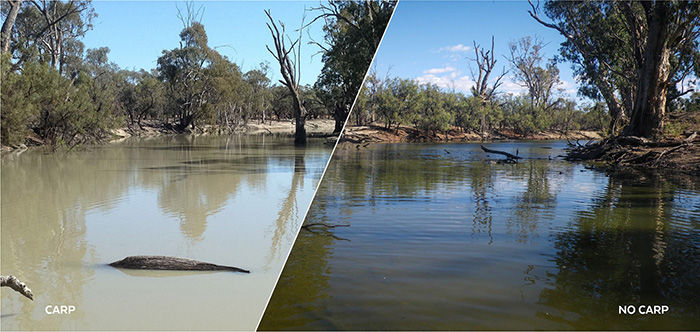Carp (Cyprinus carpio) have been in Australia for over 100 years and are now established in all states and territories, except the Northern Territory and Tasmania (where recent eradication efforts in a closed lake system have been successful).
Carp completely dominate freshwater fish communities in southeastern Australia. In many areas they comprise a significant proportion of fish biomass, sometimes exceeding 80% or 350 kilograms per hectare in parts of the Murray-Darling Basin.
Carp impacts are felt environmentally, economically and socially. They affect water quality, native fish, fishing and irrigation.
The key impacts of carp are as follows:
- Carp are ecosystem engineers, modifying waterways by their feeding style of syphoning sediment from the riverbed, filtering out food items and ejecting the remaining material into the water around them. This syphoning action stirs up silt and erodes river banks. It also muddies the water, blocking sunlight to aquatic vegetation and impacting plankton, aquatic invertebrates, waterbirds and native fish.
- Carp’s feeding activity lowers water quality and increases nutrient levels. This in turn impacts zooplankton, which normally feed on microscopic planktonic algae. When combined, these factors can contribute to blue-green algal blooms that impact recreational use of waterways (e.g. swimming, skiing etc.).
- Carp are highly successful at competing with native fish for food resources. This particularly impacts smaller native fish species, but also affects larger species higher up the food chain. Some native species, like Murray Cod, eat small carp but this is not their natural food source.
- Carp are not a preferred species for many Australian anglers. People go fishing to spend time with friends, get outdoors and maybe catch a few fish. Catching carp can be fun, but most anglers prefer to catch native species. Carp currently undermine the recreational fishing industry in Australia, which is worth billions of dollars.

The image above shows the benefits of removing carp from an area. This wetland dried out, carp were prevented from returning using a screen and the system filled again naturally. The improved water clarity is clear to see. Read more about this experiment.
Carp have been identified as a priority pest species, both in Australia and internationally. The International Union for Conservation of Nature has named carp one of the world’s most invasive fish species.
A recent national survey reported that the public perceive carp as the fourth most significant vertebrate pest in Australia (after cane toads, feral cats and rabbits). For at least the last two decades, there has been a shared desire among natural resource management agencies and communities for control programs to reduce these impacts.
Australia is working hard to rehabilitate rivers and wetlands. Significant investment, in fishways, environmental watering and other measures, is being compromised by carp.






